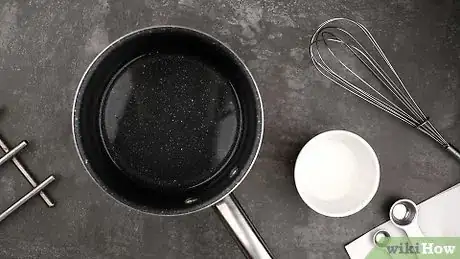This article was co-authored by wikiHow Staff. Our trained team of editors and researchers validate articles for accuracy and comprehensiveness. wikiHow's Content Management Team carefully monitors the work from our editorial staff to ensure that each article is backed by trusted research and meets our high quality standards.
There are 7 references cited in this article, which can be found at the bottom of the page.
The wikiHow Video Team also followed the article's instructions and verified that they work.
This article has been viewed 93,841 times.
Learn more...
Coconut oil melts from its solid form at 76°F (24°C) into a liquid which is commonly used in cooking, health, and beauty products. If you live in a warmer location, your coconut oil might already be ready to use at any time, as it will already be in liquid form. However, if you live in a colder climate, you can easily melt the coconut oil using hot water, a microwave, or a stovetop.
Steps
Using Hot Water
-
1Fill up a sink with hot water. This method is useful if you want to melt a whole jar at once. Make sure that the sink is full enough for the container to be completely submerged by the water.
- You could also use a bucket instead if the whole sink is too big to fill up.
-
2Place the container of coconut oil in the water. Make sure that the lid is screwed on tight. The water should be higher than the lid of the jar, otherwise the oil won't melt evenly.
- If the container floats in the water, place something heavy on top of it. A plate works well for keeping the coconut oil submerged in the hot water.
Advertisement -
3Remove the container from the sink after 90 seconds. It will take between 1 to 2 minutes for the oil to fully melt. Dry off the container with a tea towel, and then measure out the amount of liquid coconut oil you need.
- After you measure out the amount of coconut oil you need, it will solidify again if the temperature is below 76°F (24°C).[1]
Melting in a Microwave
-
1Use a spoon to scoop some coconut oil out of the jar. Use a sturdy spoon to take out some solid coconut oil from the container. Place this into a measuring cup or spoon, and pack it down to get an accurate measurement.
- If the coconut oil is very hard and brittle, use a tablespoon and scrape it repeatedly across the surface. The oil that has been scraped away will form a paste consistency.
-
2Put the coconut oil in a microwave-safe dish. Spoon the coconut oil out of the measuring cup or spoon and into the dish. Using a lid on the microwave dish will also help to keep your microwave clean.
-
3Heat the coconut oil in the microwave for 10-second intervals. Coconut oil melts relatively fast using a microwave, so small time intervals work best. For reference, it takes roughly 45 seconds to melt ½ cup of coconut oil in the microwave.[2]
- The actual time that it will take for the coconut oil to melt will depend on the make and wattage of your microwave.
- Between each 10-second interval, give the coconut oil a good stir to help it melt evenly.[3]
Using a Stovetop
-
1Measure out the amount of coconut oil you need. Use a measuring spoon or cup to determine the amount of coconut oil that you will need. Similar to flour or other baking products, pack the coconut oil down, and smooth off the edges when being measured to get the most precise amount.[4]
- If scraping the solid coconut oil is proving difficult and you use it regularly, an ice cube tray may be useful. Melt a container of coconut oil, and then distribute it across an ice cube tray. Refrigerate the coconut oil until solid again, and then you have small portions ready to be used at ease.[5]
-
2Heat the coconut oil on the stovetop for 2 minutes. Use a small pot over a low heat, and stir the coconut oil regularly. This is especially useful if you want to use the same pot for cooking with the coconut oil once it has melted, such as for popping popcorn.[6]
- You can use a frying pan instead to heat the coconut oil. This is helpful if you are planning to fry chicken or make pancakes using the oil.
-
3Remove the coconut oil from the heat when it is a clear liquid. This means that the melted coconut oil is ready to use. If you have accidentally melted too much, it will solidify again at a cool enough temperature.
References
- ↑ http://coconutresearchcenter.org/hwnl_3-1.htm
- ↑ https://www.thekitchn.com/how-do-i-use-coconut-oil-in-recipes-good-questions-187047
- ↑ https://www.fifteenspatulas.com/coconut-oil-brownies/
- ↑ http://www.yummymummyclub.ca/blogs/nicole-macpherson-meatless-mummy-con-carne/20150113/vegan-kitchen-hack-using-coconut-oil-to
- ↑ https://www.healthstartsinthekitchen.com/2013/04/26/perfectly-portioned-coconut-oil/
- ↑ https://www.thekitchn.com/how-to-make-the-most-buttery-movie-style-popcorn-240547
- ↑ http://coconutresearchcenter.org/hwnl_3-1.htm
- ↑ https://www.seriouseats.com/2014/05/cooking-fats-101-whats-a-smoke-point-and-why-does-it-matter.html
About This Article
To melt coconut oil in a microwave, start by scooping some of it into a microwave-safe bowl. Then, heat the coconut oil in the microwave for 10-second intervals until it melts, stirring it after each interval. You can also melt coconut oil using hot water. Just fill up a sink with hot water, submerge the container of coconut oil in it, and let it sit for 1-2 minutes or until the oil is fully melted. To learn how to melt coconut oil on the stovetop, scroll down!






-Step-1.webp)




















-Step-1.webp)




































